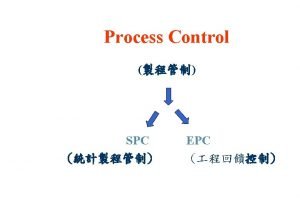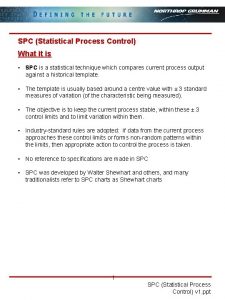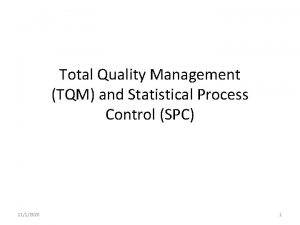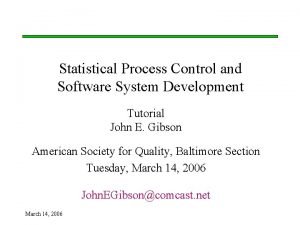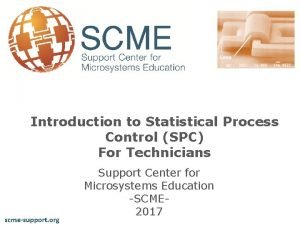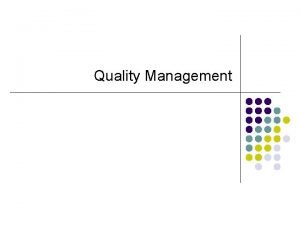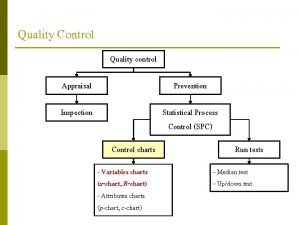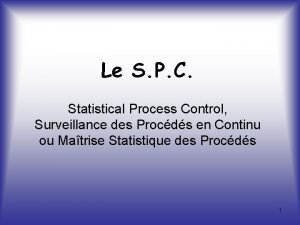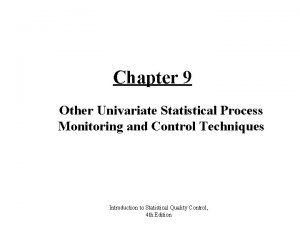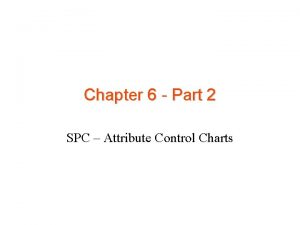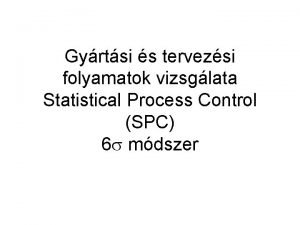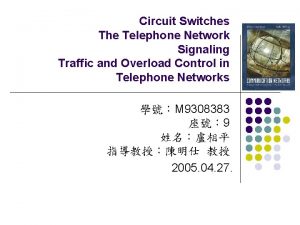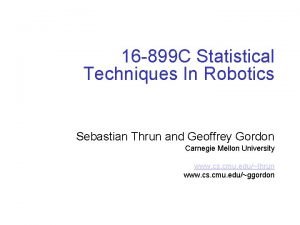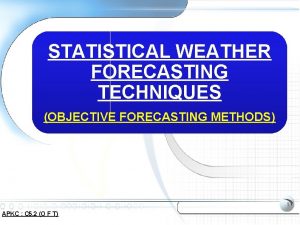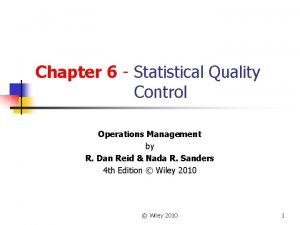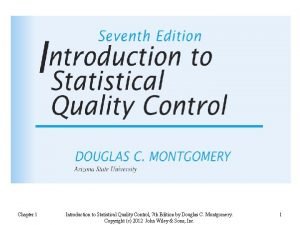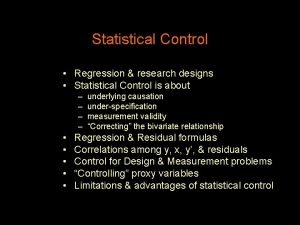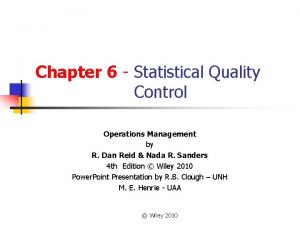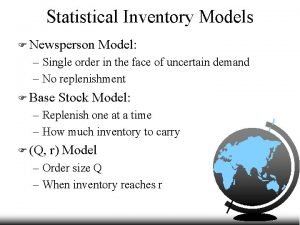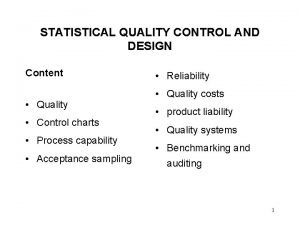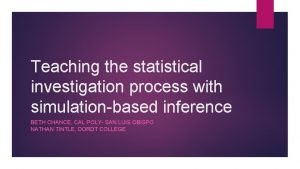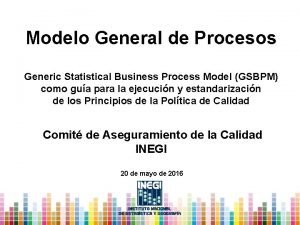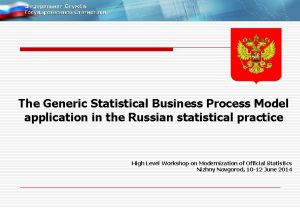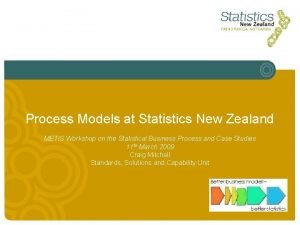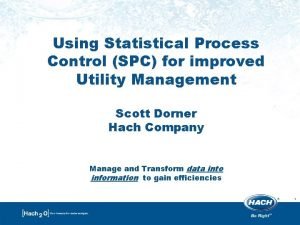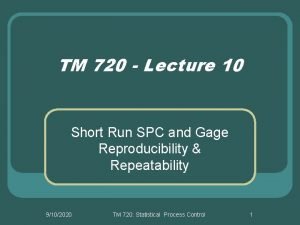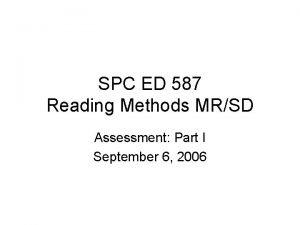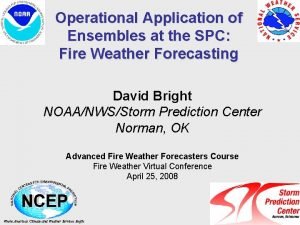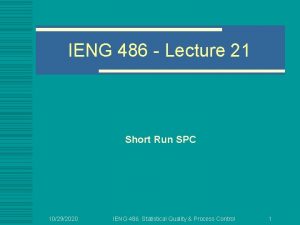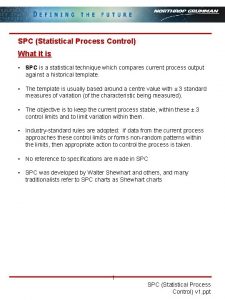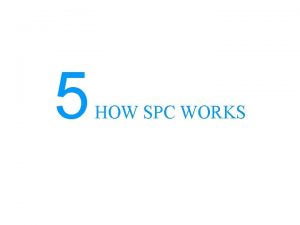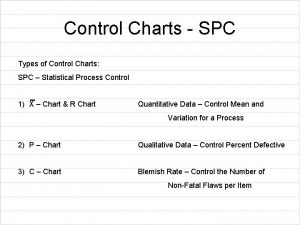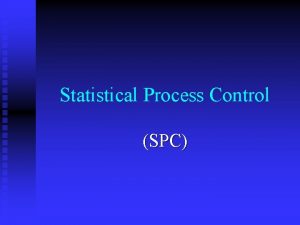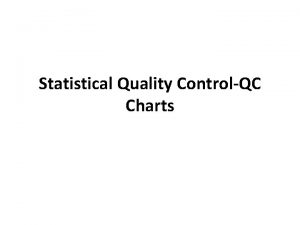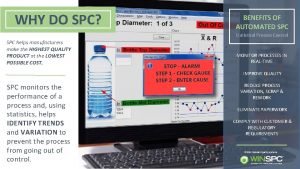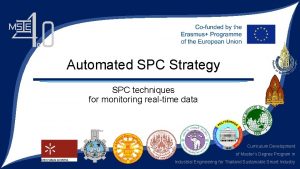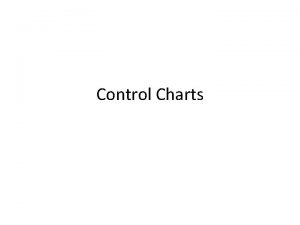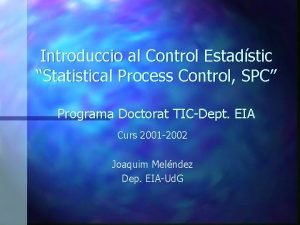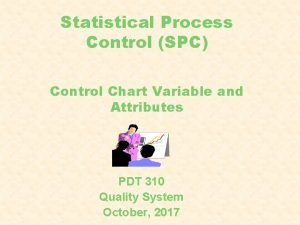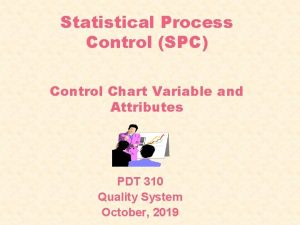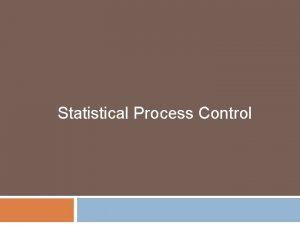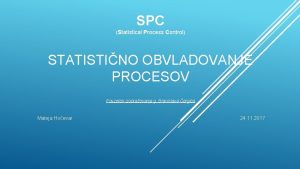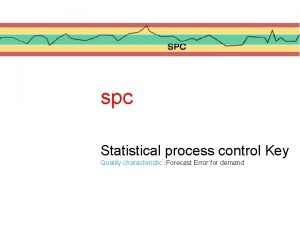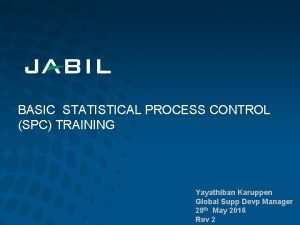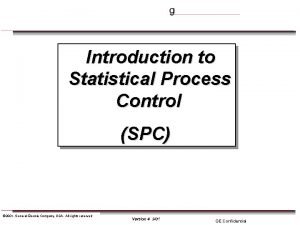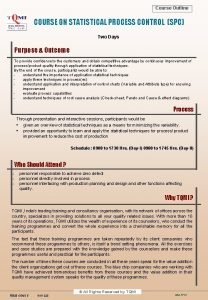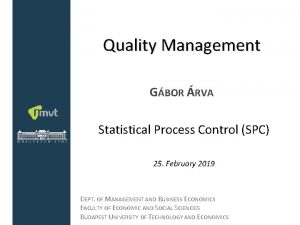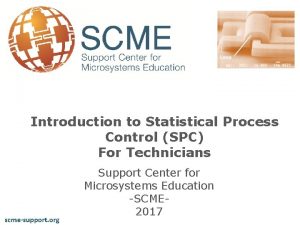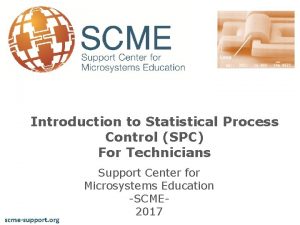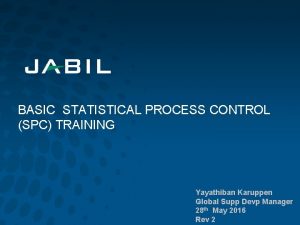Process Control Techniques SPC Statistical Process Control Parts

































- Slides: 33


Process Control Techniques SPC (Statistical Process Control): Parts industry n Control Chart (W. A. Shewhart, 1920) n Applied Statistics and Industrial Engineering n EPC (Engineering Process Control): continuous process n Feedback Control Scheme (Box and Jenkins, 1976) n Chemical and Electrical Engineering n

Statistical Process Control (SPC)

Main idea of SPC To monitor the stability of product’s quality characteristics (measurable attributes). • Process monitoring is more passive action • Common and assignable causes variability • In-control state and out-of-control (OOC) state • Control chart distinguishes these two states. • Process unchanged if no OOC signal appears • Take action if OOC signal has been detected

Engineering Feedback Control (EPC) Disturbance Input Process Feedback Control Output

Either SPC or EPC are not enough in IC manufacturing process 1. SPC only detects the changes of process but does not prescribe suitable control actions. 2. IC manufacturing process consists of several chemicalbased, batch-by-batch sub-processes. 3. EPC can not be used directly. The reasons are (a) A precise I-O model is unknown; (b) EPC has the danger of over-adjustment.

Run by Run (Rb. R) Control 針對 IC 產業 Run-by-Run 之特性所發展出 來的製程管制方法,它整合 n DOE (Design of Experiment) n EPC (Engineering Feedback Control) n SPC (Statistical Process Control) 之優點來監控 IC 生產製程。

批次控制架構 (Run by Run Control) start RSM Optimal Post-measured data A new recipe Yes SPC No change No Out of deadband? No Out of limits of the recipe? Yes Clean and maintain Update Feedback control EPC

The case of SISO System Process EWMA controller Question : (1) stability conditions (2) optimal discount factor ω

Supervisory APC of Poly-Loop for Isat CMP Cpk improve 20 -30 % ADI CD Cpk improve 20 -30 % AEI CD CPK improve 10 -25% Device Cpk improved 20 -30% FF FF CVD FF CMP Film information FF FF ADI CD Poly Photo FB FB FF Dimension offset of Mask NTO (New Tape Out) rework rate reduce 20 -30% AEI CD Poly Etch electrical performance Implant FB FB

Supervisory APC of Cu Resistance Cpk of Cu-Rs improved 30 -40% FF of OX thickness FF of OX CD OX Film OX THK Metal trench etch trench CD Cu ECP Cu THK CMP Thk after CMP WAT/CP performance FB FF of Cu thickness FF FB : Feed forward : Feedback FB of remained thk FB FB to control island


APC Challenges:

FDC Benefits • Learn more about the equipment behavior • Learn more about the process behavior • Improve the equipment reliability • Reduce the number of test wafers • Match chambers and equipments • Identify the root cause of faults • Optimize the frequency and the nature of PMs • Reduce wafer scrap • Capitalize process knowledge and experience

Collect temporal data and record it in a data base Visualize the temporal data Choose the correct pretreatment to summarize data Univariate SPC Model FDC methodology Data Collection Data Monitoring Pretreatment Setup upper and lower limits fora Build Define a corrective each summarized multivariate action on both SPC data model including and GPC fault T² global detectionand indicator faults signatures SPC OCAPs GPC Model

FDC methodology Step 0 - Data Collection Goal • Collect the necessary data that will be used to represent and understand the process and/or the equipment behavior. Benefits • Choose the parameters to collect Ø Equipment status variables (SVID) Ø Analog and digital inputs Ø External sensors l Choose the sampling rate for each parameter l Define the Start and Stop events that trigger the data collection (Recipe name, Steps numbers. . . )

FDC methodology Step 1 - Data Monitoring Goal l Visualize the temporal data to understand each physical parameter Benefits l l Choose and visualize the relevant temporal variables See if the variable is meaningful, synchronized with the run. . . l Control the temporal behavior l Start and stop manually the real time data collection

FDC methodology Step 2 - Pre-treatment Goal • Summarizing temporal data in one or several indicator(s) called univariate data. According to the temporal behavior of the variable, this summary may be a mean, a range, a standard deviation etc…and becomes time independent. Benefits • Create several summarized indicators with only one temporal data. • Choose the temporal data and associate a pre-treatment. • Visualize the new summarized indicator on a graph

FDC methodology Step 2 – Pre-treatment Temporal collected Data Pre-treatment (mean, range etc…) Data Base Table for Univariate data Univariate Chart

FDC methodology Step 3 - Modeling Goal • Create a reference of the good behavior of the process Benefits • Automatic control of the process by FDC

FDC methodology Step 3 - Modeling SPC Chart T 2 Chart Univariate Data (Pretreated) Modeling (SPC/GPC) Alarm Index Chart Sensitivity Chart Models

FDC methodology Univariate Modeling with SPC Goal l Control the process variables with a univariate criteria the control limits. Each control depends on a probability of false alarm. Benefits l l Control limits are either statistical or specified Several control limits aims to have several levels of severity.

FDC methodology Univariate Modeling with SPC Univariate Data Control limits Univariate Chart including all upper and lower limits

FDC methodology Multivariate Modeling with GPC Goal l Control the process by Ø using Hotelling T² probabilistic limit to discriminate Out of Control wafers from the Under Control wafers. Ø using GPC factorial analysis to classify out of control wafers and to provide a list of Fault Signature Benefits l Use the control charts and sensitivity charts to analyze the abnormal behaviors and to understand the origin of the anomalies.

FDC methodology Multivariate Modeling with GPC Choice of the GPC input indicators Univariate Data Close to random gaussian behavior?

FDC methodology Multivariate Modeling with GPC Model Parameters Univariate Data Discrimination & Fault Classification & Fault Signature Alarm level

FDC methodology Step 4 – OCAP Goal • Act to better control the process Benefits • Use SPC/GPC analysis to build the OCAPs • OCAPs automatically implemented

Data Quality is • Data Availability Same data that the equipment supplier requires for the purposes of tool control • Sampling Rate Data shall be provided with a sampling rate at least twice, as a minimum, the period of the shortest anomaly or signature to be detected on the signal • Data Resolution of no less than. 1% of normal operating range • Data Accuracy An absolute accuracy of no less than. 05% of normal operating range

Data Quality is • Data collection Trigger must have the ability to be triggered based on a command from the host, on a recipe step, a specified equipment event or a combination of specified equipment events • Data Delivery Data shall be made available to internal or external systems within 50 milliseconds of being sampled • Time and Date Stamp Data must be time and date stamped, and synchronized. Time-stamping must correspond to the occurrence of the corresponding event or sample value. • Sensor tracking Sensors providing data shall provide the means of tracking their make, model, serial number. And last bench calibration date.

Pre-treatment Summarization Formula Samples Name Description Maximum of the data Minimum of the data Range Difference between max and min Empirical Mean Average value of one population Temporal Mean Average value of one temporal population Empirical Standard Deviation Represents the dissipation of one population. Temporal Standard Deviation Represents the dissipation of one temporal population. Formula

Pre-treatment What is important in this temporal chape? How to highlight it? Standard Deviation Algorithm Standard deviation aims to highlight the stability in the variations Other algorithms Mean Algorithm Mean aims to highlight the stability in mean

Pre-treatment Regression This summarization allows controlling the slope and offset of temporal drifts. The results of this time regression are 2 indicators, the 2 coefficients of regression: Slope Observation. ID Offset Time Observation. ID

Final Exam Questions: Please explain APC function, and describe the benefit of APC function in semiconductor industry. (20%) Please explain FDC function, and describe the benefit of FDC function in semiconductor industry. (20%) Please describe the challenges of implementing the APC in semiconductor industry. (15%) Please explain the integrated synergy of APC and FDC working model. (20%) Please describe the data quality defined to support FDC functions. (10%) Please illustrate several pre-treatmenet for convert FDC’s temporal charts into SPC charts. (15%)
 Spc fdc
Spc fdc Statistical process control ppt
Statistical process control ppt Spc in total quality management
Spc in total quality management Statistical process control tutorial
Statistical process control tutorial Sandia
Sandia Quality
Quality 20 ของ300
20 ของ300 Controle spc
Controle spc Statistical process control
Statistical process control P chart control limits
P chart control limits Spc control chart
Spc control chart Spc switching system overload control
Spc switching system overload control Statistical techniques in robotics
Statistical techniques in robotics Weather forecasting techniques
Weather forecasting techniques Alex teichman
Alex teichman What is sqc in operations management
What is sqc in operations management Introduction to statistical quality control montgomery
Introduction to statistical quality control montgomery Statistical control in research
Statistical control in research Statistical quality control in operations management
Statistical quality control in operations management Introduction to statistical quality control
Introduction to statistical quality control Statistical inventory control
Statistical inventory control Variables and attributes in quality control
Variables and attributes in quality control Theory based inference applet
Theory based inference applet Generic statistical business process model
Generic statistical business process model Uiiss
Uiiss Promotions o'cool
Promotions o'cool Fonctions techniques et solutions techniques
Fonctions techniques et solutions techniques Spc meaning
Spc meaning Short run spc
Short run spc Spc database
Spc database Spc 587
Spc 587 Spc sref
Spc sref Short run spc
Short run spc Spc sref
Spc sref
